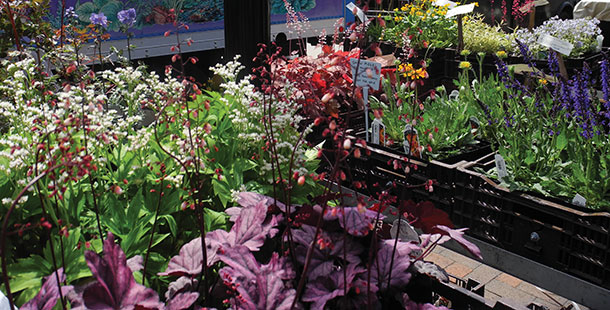Springtime truly arrives in Madison when the outdoor Dane County Farmers Market returns to the Capitol Square. April 19 was the first market of the spring. This marks the beginning of a new growing season, and with it, greater opportunity to support sustainable local food producers.
Southern Wisconsin supports a rich variety of farmers and craftspeople. The outdoor farmers market brings vendors from all over the state, and all with the same goal: to vend their self-produced vegetables, cheese, meats, and many other unique and interesting items.
Shopping at the Dane County farmers market ensures that you’re supporting people that are working directly with the food or goods you’re buying. Buying from local producers has a slew of advantages and benefits, including more knowledge about the food you eat.
Felix Thalhammer owns and operates Capri Farms. There he produces a delicious variety of goat cheese. He’s proud of his craft, and the Dane County Farmers market is unique is that it only allows food producers as vendors. “I’m not buying my cheese to sell it here,” Thalhammer said, “I make it.”
On Saturday, he was happy to be back on the square; the first market is often one of the most profitable of the year. The Dane County market runs all year, going indoors at the Monona Terrace in November and then moving to the Capital Senior Center for the rest of the winter. According to Thalhammer, the indoor market sees only about 30 percent of the business that the outdoor markets bring. Something to keep in mind for next winter, Madison almost always has local food available in some fashion or another.
Today many people pay little attention to the food they consume and where it comes from. Fast and processed foods comprise the the majority of many diets, and the problems arising from these practices are apparent. The surging rates of diseases like cancer, mental illness, and cardiac arrest points to something very misguided in the way we treat our bodies. The convenient additions to the Standard American Diet of fast food and processed meals have left people disconnected from the source of their nourishment.
Prior to World War I, 40 percent of vegetables consumed in the United States grew in home gardens. Victory gardens eased the pressure on nation food supply in wartimes. Ironically, Americans now throw away about 40 percent of the food they buy. This accumulates as landfill waste, polluting the environment and eating away at people’s budgets. Buying locally instills a greater appreciation for the food you’re purchasing. Wasting food from the farmers market seems especially sad since you met the person who grew that tomato. It’s throwing their work in the trash.
Getting your fruits and veggies at a local market also reduces strain on the environment that conventional methods of produce production bring. Food that is grown nearby travels less from the farm to your fork. This saves fuel from shipping, and energy from storing and cooling products. Would you rather eat a tomato journeying 4000 miles from Chile, ripened with ethylene gas? Or one that came from a farm 40 miles away, and sold to you by the farmer that can tell you why that variety of tomato is so unique? The second tomato will taste superior, rest assured.
Madison holds one of the best outdoor markets of in the nation, and provides opportunity for sustainable local farmers to share their goods with the non-growers here. Take advantage of this chance and see what you can find. A newly discovered vegetable could be your next main course.


























